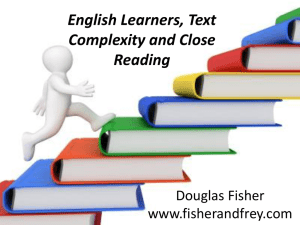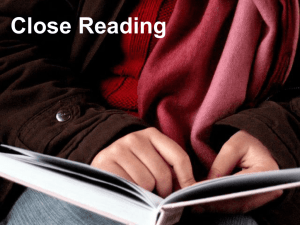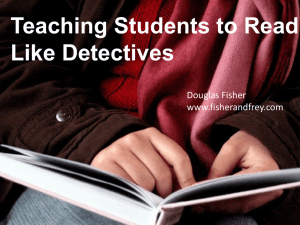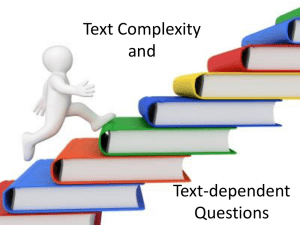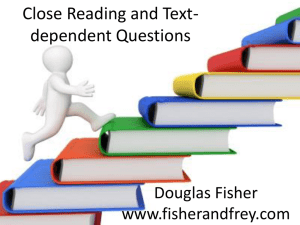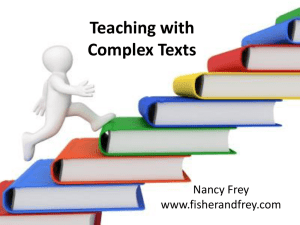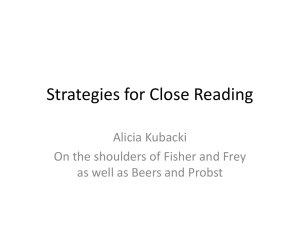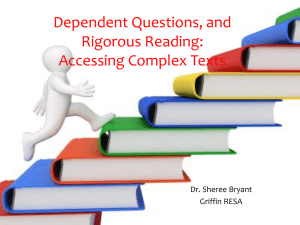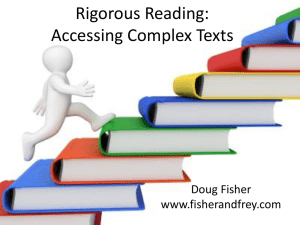Session Handouts
advertisement
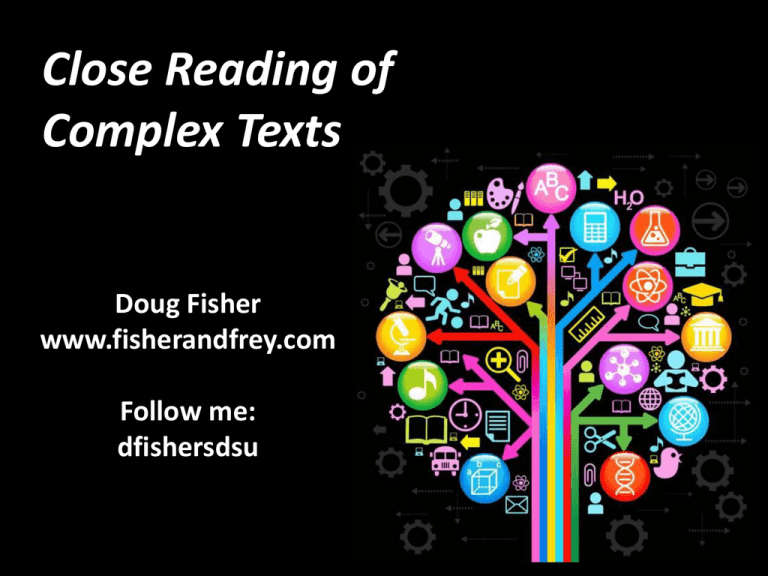
Close Reading of Complex Texts Doug Fisher www.fisherandfrey.com Follow me: dfishersdsu To identify the essential components of close reading (RL/RI 1) of complex texts (RL/RI 10) which includes collaborative conversations (S & L 1) and writing from sources (W 1), fostering language development (L 6) and deeper thinking. 10. Read and comprehend complex literary and informational texts independently and proficiently. Simply assigning hard books will not ensure that students learn at high levels! To build strength Less Complex To build stamina More Complex 1. Read closely to determine what the text says explicitly and to make logical inferences from it; cite specific textual evidence when writing or speaking to support conclusions drawn from the text. Use a short passage Creating a Close Reading Use a short passage Re-reading Creating a Close Reading Facilitating Re-reading Change the task Read for flow. Read for annotation. Ask a really good question What is the author’s belief about war? Press for evidence Where did you find that? Use a short passage Re-reading “Read with a pencil” Creating a Close Reading Foundational Annotation Skills • Underline the major points. • Circle keywords or phrases that are confusing or unknown to you. • Write margin notes restating the author’s ideas. Additional Annotations • Use a question mark (?) for questions that you have during the reading. Be sure to write your question. • Use an exclamation mark (!) for things that surprise you, and briefly note what it was that caught your attention. • Draw an arrow (↵) when you make a connection to something inside the text, or to an idea or experience outside the text. Briefly note your connections. • Mark EX when the author provides an example. • Numerate arguments, important ideas, or key details and write words or phrases that restate them. Annotation with Wikki sticks Student annotation in 6th grade Student sample from Leigh McEwen, AEA 9, Iowa Use a short passage Re-reading “Read with a pencil” Text-dependent questions Creating a Close Reading Progression of Text-dependent Questions What does the text mean? How does the text work? Opinions/Arguments, Intertextual Connections Inferential Inferences Author’s Craft and Purpose Vocab & Text Structure Key Details Structural General Understandings • Overall view • Sequence of information • Story arc • Main claim and evidence • Gist of passage General Understandings in Kindergarten Retell the story in order using the words beginning, middle, and end. Key Details • Search for nuances in meaning • Determine importance of ideas • Find supporting details that support main ideas • Answers who, what, when, where, why, how much, or how many. Key Details in Kindergarten • How long did it take to go from a hatched egg to a butterfly? • What is one food that gave him a stomachache? What is one food that did not him a stomachache? It took more than 3 weeks. He ate for one week, and then “he stayed inside [his cocoon] for more than two weeks.” Foods that did not give him a stomachache • • • • • • Apples Pears Plums Strawberries Oranges Green leaf Foods that gave him a stomachache • • • • • • • • • • Chocolate cake Ice cream Pickle Swiss cheese Salami Lollipop Cherry pie Sausage Cupcake watermelon Vocabulary and Text Structure • Bridges literal and inferential meanings • Denotation • Connotation • Shades of meaning • Figurative language • How organization contributes to meaning Vocabulary in Kindergarten How does the author help us to understand what cocoon means? There is an illustration of the cocoon, and a sentence that reads, “He built a small house, called a cocoon, around himself.” Author’s Craft & Purpose • Genre: Entertain? Explain? Inform? Persuade? • Point of view: First-person, third-person limited, omniscient, unreliable narrator • Literary devices: personification, metaphors, etc. Author’s Craft & Purpose in Kindergarten Who tells the story—the narrator or the caterpillar? A narrator tells the story, because he uses the words he and his. If it was the caterpillar, he would say I and my. Inferences Probe each argument in persuasive text, each idea in informational text, each key detail in literary text, and observe how these build to a whole. Inferences in Kindergarten The title of the book is The Very Hungry Caterpillar. How do we know he is hungry? The caterpillar ate food every day “but he was still hungry.” On Saturday he ate so much food he got a stomachache! Then he was “a big, fat caterpillar” so he could build a cocoon and turn into a butterfly. Opinions, Arguments, and Intertextual Connections • • • • • • Author’s opinion and reasoning (K-5) Claims Evidence Counterclaims Ethos, Pathos, Logos Rhetoric Links to other texts throughout the grades Opinions and Intertextual Connections in Kindergarten Narrative Informational Is this a happy story or a sad one? How do you know? How are these two books similar? How are they different? 1877 What does the text say? General Understanding What does the text say? General Understanding What does the text say? Key Details Select some one in your group to read the speech aloud. Add pauses, inflections, intonations, and emphasis (prosody) to the text. How does the text work? Vocabulary How does the text work? Vocabulary What is the tone of this speech? What words and phrases support your claim? How does the text work? Structure How does the text structure convey Chief Joseph’s mood? How does the text work? Structure What is it about the use of the word forever in the last line, “I will fight no more forever” that makes this statement so memorable? What does the text mean? Intertextual connections “My son, my body is returning to my mother earth, and my spirit is going very soon to see the Great Spirit Chief. When I am gone, think of your country. You are the chief of these people. They look to you to guide them. Always remember that your father never sold his country. You must stop your ears whenever you are asked to sign a treaty selling your home. A few years more and white men will be all around you. They have their eyes on this land. My son, never forget my dying words. This country holds your father's body. Never sell the bones of your father and your mother.” Joseph commented "I clasped my father's hand and promised to do as he asked. A man who would not defend his father's grave is worse than a wild beast." What does the text mean? Intertextual connections What does the text inspire you to do? • Presentation • Debate • Writing • Socratic seminar • Investigation and research • Test Thank you!
